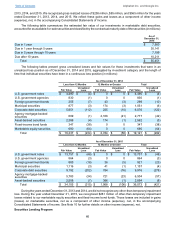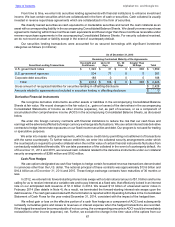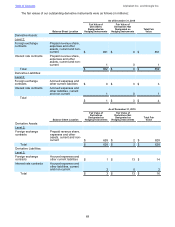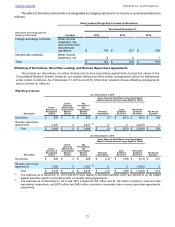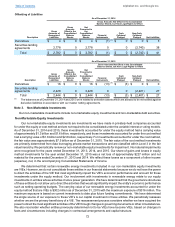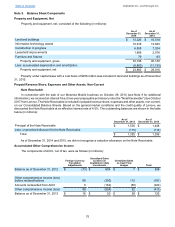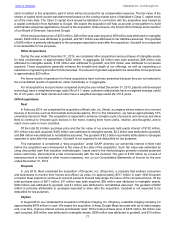Google 2015 Annual Report Download - page 71
Download and view the complete annual report
Please find page 71 of the 2015 Google annual report below. You can navigate through the pages in the report by either clicking on the pages listed below, or by using the keyword search tool below to find specific information within the annual report.
Table of Contents Alphabet Inc. and Google Inc.
67
From time to time, we enter into securities lending agreements with financial institutions to enhance investment
income. We loan certain securities which are collateralized in the form of cash or securities. Cash collateral is usually
invested in reverse repurchase agreements which are collateralized in the form of securities.
We classify loaned securities as cash equivalents or marketable securities and record the cash collateral as an
asset with a corresponding liability in the accompanying Consolidated Balance Sheets. We classify reverse repurchase
agreements maturing within three months as cash equivalents and those longer than three months as receivable under
reverse repurchase agreements in the accompanying Consolidated Balance Sheets. For security collateral received,
we do not record an asset or liability except in the event of counterparty default.
Our securities lending transactions were accounted for as secured borrowings with significant investment
categories as follows (in millions):
As of December 31, 2015
Remaining Contractual Maturity of the Agreements
Securities Lending Transactions Overnight and
Continuous Up to 30
days 30 - 90
Days Greater Than
90 Days Total
U.S. government notes $ 1,322 $ 31 $ 0 $ 306 $ 1,659
U.S. government agencies 504 77 0 0 581
Corporate debt securities 188 0 0 0 188
Total $ 2,014 $ 108 $ 0 $ 306 $ 2,428
Gross amount of recognized liabilities for securities lending in offsetting disclosure $ 2,428
Amounts related to agreements not included in securities lending in offsetting disclosure $ 0
Derivative Financial Instruments
We recognize derivative instruments as either assets or liabilities in the accompanying Consolidated Balance
Sheets at fair value. We record changes in the fair value (i.e., gains or losses) of the derivatives in the accompanying
Consolidated Statements of Income as other income (expense), net, as part of revenues, or as a component of
accumulated other comprehensive income (AOCI) in the accompanying Consolidated Balance Sheets, as discussed
below.
We enter into foreign currency contracts with financial institutions to reduce the risk that our cash flows and
earnings will be adversely affected by foreign currency exchange rate fluctuations. We use certain interest rate derivative
contracts to hedge interest rate exposures on our fixed income securities and debt. Our program is not used for trading
or speculative purposes.
We enter into master netting arrangements, which reduce credit risk by permitting net settlement of transactions
with the same counterparty. To further reduce credit risk, we enter into collateral security arrangements under which
the counterparty is required to provide collateral when the net fair value of certain financial instruments fluctuates from
contractually established thresholds. We can take possession of the collateral in the event of counterparty default. As
of December 31, 2014 and 2015, we received cash collateral related to the derivative instruments under our collateral
security arrangements of $268 million and $192 million.
Cash Flow Hedges
We use options designated as cash flow hedges to hedge certain forecasted revenue transactions denominated
in currencies other than the U.S. dollar. The notional principal of these contracts was approximately $13.6 billion and
$16.4 billion as of December 31, 2014 and 2015. These foreign exchange contracts have maturities of 36 months or
less.
In 2012, we entered into forward-starting interest rate swaps with a total notional amount of $1.0 billion and terms
calling for us to receive interest at a variable rate and to pay interest at a fixed rate, that effectively locked in an interest
rate on our anticipated debt issuance of $1.0 billion in 2014. We issued $1.0 billion of unsecured senior notes in
February 2014 (See details in Note 4). As a result, we terminated the forward-starting interest rate swaps upon the
debt issuance. The cash gain associated with the termination is reported within Operating Activities in the Consolidated
Statement of Cash Flows for the year ended December 31, 2014, consistent with the impact of the hedged item.
We reflect gain or loss on the effective portion of a cash flow hedge as a component of AOCI and subsequently
reclassify cumulative gains and losses to revenues or interest expense when the hedged transactions are recorded.
If the hedged transactions become probable of not occurring, the corresponding amounts in AOCI would be immediately
reclassified to other income (expense), net. Further, we exclude the change in the time value of the options from our











